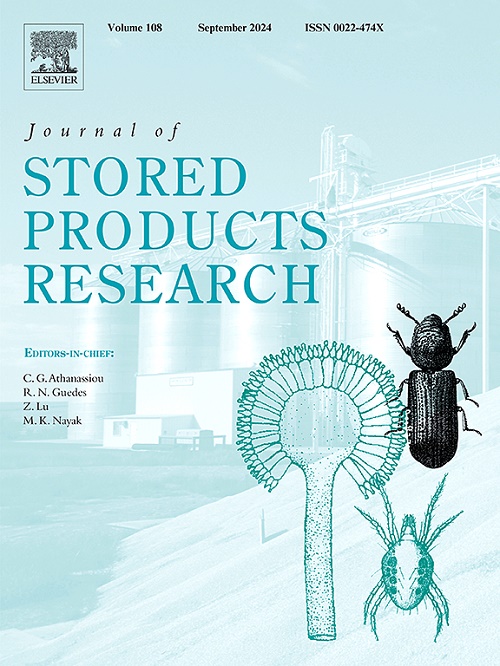Long-term efficacy of diatomaceous earth, SilicoSec® against three major stored grain insect pests
IF 2.7
2区 农林科学
Q1 ENTOMOLOGY
引用次数: 0
Abstract
Diatomaceous earth (DE), which possesses low mammalian toxicity and stability on grain, has promising potential in controlling stored grain pests. However, only a few published studies focus on the effectiveness during the long term storage. The current study assessed the long-term efficacy of DE, SilicoSec® on Sitophilus granarius, Rhyzopertha dominica, and Tribolium confusum using infestation with two adults per kg of wheat. The population density of each pest was monitored throughout one year in 50 kg of stored wheat treated with three doses of SilicoSec® (500, 1000, and 2000 mg/kg grain) in drums under laboratory condition. The number of adults (dead or alive) for S. granarius, R. dominica, and T. confusum was 8.00 ± 1.73, 2.00 ± 0.58 and 1.00 ± 0.58, respectively, at 2000 mg/kg dose of DE by 12 months of storage. The suppression rate was 95.2, 99.4, and 97.9% for S. granarius, R. dominica, and T. confusum, respectively, at 1000 mg/kg DE after 12 months of storage.
This study showed that wheat treated with SilicoSec® at 1000 mg/kg could be satisfactorily protected against major stored grain pests for a year. SilicoSec® has great residual efficacy for a year, which is generally not achievable with residual grain protectants.

求助全文
约1分钟内获得全文
求助全文
来源期刊
CiteScore
5.70
自引率
18.50%
发文量
112
审稿时长
45 days
期刊介绍:
The Journal of Stored Products Research provides an international medium for the publication of both reviews and original results from laboratory and field studies on the preservation and safety of stored products, notably food stocks, covering storage-related problems from the producer through the supply chain to the consumer. Stored products are characterised by having relatively low moisture content and include raw and semi-processed foods, animal feedstuffs, and a range of other durable items, including materials such as clothing or museum artefacts.

 求助内容:
求助内容: 应助结果提醒方式:
应助结果提醒方式:


